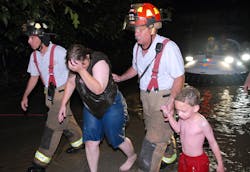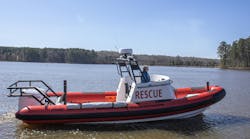With climate change, hurricanes and widespread flooding, firefighters nationwide are finding themselves involved in water rescues with increasing frequency. Whether it is by happenstance or by design, firefighters are often found to be performing water rescues or working in flood waters wearing turnout gear.
With this thought in mind, Firehouse asked a few makers of turnout gear for their thoughts about wearing structural firefighting turnout gear while working in flood waters. Their answers were unanimous – don’t do it. At least don’t do it with forethought.
“Bad idea,” said Rob Freese, vice president of sales and marketing for New Hampshire-based Globe Manufacturing. “I’d say that as a general statement.”
Freese, whose ancestor founded the business in 1887, has been in the turnout gear business for decades. He is also a firefighter in New Hampshire and a boating educator with the State Police Marine Patrol division. So he knows about firefighter turnout gear and about water safety.
“Using turnout gear around water is not a good idea,” said Freese. He said today’s turnout gear has three layers for thermal protection and to keep water from penetrating and were never meant for water rescue scenarios.
PPE history lesson
Offering a bit of a history lesson on turnout gear, Freese said fire suits were originally developed in New England and were designed to offer protection against the elements. And in the days of the bucket brigades, they became water resistant and were good garments for those kinds of uses. In the 1960s, turnout gear “morphed” into being garments for heat and flame resistance.
Freese said when firefighters don turnout gear, they should think about using it for thermal protection, not for jumping in the water for a rescue.
“It’s not that flexible and it really doesn’t provide the kind of protection that’s needed,” he said.
When considering flood water, Freese said firefighters should think about what might be in that water. Raw sewage, chemicals, stuff from garages, creatures and snakes are just some of the hazards that might be found in flood waters, Freese said, pointing out that structural firefighting turnout gear offers no protection to those hazards.
Perhaps the only part of a turnout gear ensemble that might work for water rescue operations are boots, and that’s if the water is not too deep, or at least less than the height of a boot, Freese said.
“You have to keep water out of the system,” Freese said. “You have to think about what you may encounter.”
False sense of security
Freese said some firefighters might think their turnout gear offers some protection from floating debris, but it’s a false sense of security.
“Is it one piece of metal or a log, or is the whole house coming at you,” Freese said. “You just don’t know until it’s too late.” He added that water can move with such force that 6,000-pound vehicles will float and move.
“Items can be moving through the water at great speed,” Freese said, noting just the fast-moving water is enough to cause problems. “Water weighs about eight pounds per gallon,” he said. “How much force does it take to knock a person off his feet? Bulky dressing systems are not the answer.”
Freese said many water rescues can be planned with a little forethought and the proper gear can be deployed.
“You need to plan for success,” Freese said, adding that with fire, you have to act in the moment to save someone. “That’s a true emergency situation that you have to address now.”
Globe does not make water rescue gear or personal protection gear for water rescues, but Freese said there are a number of manufacturers that do, adding that the style of gear is quick to drain when submerged in water. He suggested checking with water rescue equipment manufacturers, or your local vendors, to determine what best fits for your needs.
He said even just a traffic safety vest is safer than turnout gear in the water because it is just too bulky and gets too heavy when soaked with water. “That’s not what you want to have in a water rescue,” he said. “You need to think about being athletic.”
In addition to the proper gear, Freese also recommend harnesses and personal flotation devices, especially if responders are working in swift water.
About the only time turnout gear is OK to use in a water rescue is when the water is frozen in the winter, Freese says almost facetiously. “It’s good to keep you warm when you’re standing around while the guy in the ‘Gumby suit’ goes in the water,” Freese said.
The best advice Freese offered is to make sure responders do a risk assessment before doing any water rescue.
“It’s like looking both ways before crossing the street,” Freese said. “We need to use our Rolodex of experience. What could be in that water that we don’t even see? How about 50 pounds of swimming pool chlorine, or snakes? Turnout gear doesn’t provide any protection for snake bites. Sometimes we get this Superman complex and think we can go in and rescue people and we don’t even consider physics. You have to plan for success.”
Todd Herring is the director of marketing for Fire-Dex, a maker of turnout gear based in Medina, OH. Like Freese, Herring also doesn’t think using turnout gear is appropriate for water rescues.
“The risk is too much,” Herring said. “I would not recommend it.
Herring said turnout gear uses air to provide thermal protection and can quickly become a problem in water.
“That’s the nature of the beast,” he said. “Turnout gear can go from your friend to your enemy in water because it displaces the air. He added the material can also soak up the water and become heavy, not the kind of garment one wants to be wearing in a water rescue.
Fire-Dex turnout gear is shower tested and designed so there’s no liquid penetration through the outer shell, but submersion is completely different, Herring said.
“The fire service tends to use PPE structural turnout gear for everything,” Herring said, noting that the latest data indicates that only 1.5 percent of calls are actual structure fires. “We’re an advocate for getting the right gear for the right job,” Herring said.
NFPA 1952 offers guidance
Herring said fire departments that plan to do water rescues should look to National Fire Protection Association NFPA 1952: Standard on Surface Water Operation Protective Clothing and Equipment for guidance on what they might need to be safe.
While it is still not best for water rescue, some types of wildland fire and technical rescue gear would be better than full structural firefighting gear, Herring said. He said that type of single-layer garment would at least offer abrasion protection. He said Fire-Dex does not provide gear for water protection, but some of its dealers and distributors have sources for that kind of garments.
“Look to your vendors for answers for water rescue gear,” Herring said. “We provide all kinds of protection and we understand the business. We want to make sure the responders have the right gear.”
In addition to NFPA 1952, Herring said fire departments can get information from highly qualified instructors on the variety of gear that’s available.
Herring did offer some advice for fighters who find themselves in water with turnout gear donned.
“There is trapped air in turnout gear,” Herring said. “If you can, roll over into a floating position and relax. Trapped air will keep you afloat.”
It’s, however, critically important to keep the area of interface between gloves and boots out of the water, he said, adding that sleeves and pant legs, as well as the collar around the neck, can quickly fill up with water and submerge the gear and those wearing it.
While not ideal, Herring said turnout gear can act like a personal floatation devices when absolutely necessary.
“If you stay calm, you will stay afloat,” Herring said.
“You really need to have a Plan B, C and D’,” he said. “You should be thinking, what if it happened to me? Hopefully, you’ll have a bit of time for someone to help you get out.”
Karen Lehtonen, vice president of innovation and product management for LION, a maker of turnout gear and responder apparel, based in Dayton, OH, agrees with Herring, that trapped air will keep the responder afloat for a period of time. She agreed with the other experts and said it’s best to stay out of water if you have full-turnout gear on.
“My initial inclination is you should not be donning turnout gear if you are going to a water rescue,” Lehtonen said.
She did say if a responder is suddenly confronted with a water rescue with no time change, the natural buoyancy in fabric will help keep the responder from being submerged immediately.
Lehtonen said LION has some technical rescue and rescue and recovery apparel that could work for water rescues as they have less layers, and are lighter weight than structural turnout gear. The rescue gear offers some protection from cuts and abrasions from debris that might be in the water.
“Turnout gear is heavy,” Lehtonen said. “It could, potentially cause the rescuer to sink.” She said the outer shell of the structural firefighting turnout gear is water repellant, but the air trapped in the garments will be replaced by water in the open cuffs, waists and other interface areas.
Even just using turnout pants for waist deep or less water isn’t a good idea either. “You could lose your balance and end up in the water,” she said. “I wouldn’t say turnout gear is good for water rescues in any circumstance.”









